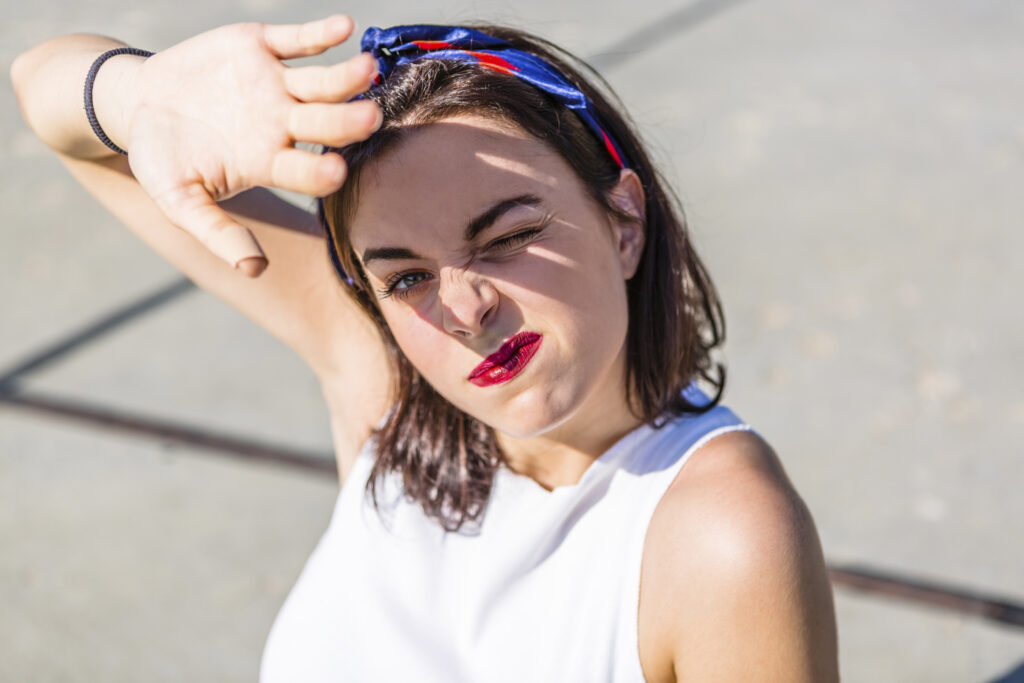Sunburn & Your Skin
The Facts. The Risks. What You Can Do.
Sunburn hurts you in more ways than one. The danger goes far beyond any short-term pain, redness and discomfort, because after the sunburn fades, lasting damage remains.
Sunburn accelerates skin aging and is a leading cause in the majority of cases of basal cell carcinoma, squamous cell carcinoma and melanoma, the deadliest form of skin cancer.
Sunburn is bad news, but the good news is that it’s totally preventable. And the best time to start is today.
Don’t feel the burn!
YOUR RISK
of developing potentially deadly melanoma
DOUBLES
with a history of 5 or more sunburns.

What is sunburn?
Sunburn is an inflammatory reaction to ultraviolet (UV) radiation damage to the skin’s outermost layers. At the heart of it all is melanin, a pigment that gives your skin its color and defends it against the sun’s rays. Melanin works by darkening your unprotected sun-exposed skin. The amount of melanin you produce is determined by genetics, which is why some people get sunburned while others tan. Both are signs of cellular damage to the skin. For people with less melanin, prolonged unprotected sun exposure can cause skin cells to become red, swollen and painful, also known as sunburn. Sunburns can range from mild to blistering.
After sunburn, your skin may start to peel. This is a sign that your body is trying to rid itself of damaged cells. Never try to peel the skin yourself; let it come off naturally. Learn more about treating a sunburn below.
What you need to know about sunburn
- Some people are more prone to sunburn: Skin type determines your susceptibility; people with fair skin run the greatest risk. But anyone can get burned.
- Even without a burn, sun exposure raises skin cancer risk. Even if you are tan or your skin type is dark and your skin does not redden, the sun can cause cellular damage that can lead to cancer.
- The UV index is a factor: The sun varies in intensity by season, time of day and geographic location. A high UV index means that unprotected skin will burn faster or more severely. Be careful, especially when the sun is strongest. But even when the index is low, the risk remains. Protect yourself every day of the year.
- You can burn on an overcast day: Be careful even when the sun isn’t shining. Up to 80 percent of UV rays can penetrate clouds.
- Light pink is still bad: No matter how mild, every burn is a sign of injury to your skin that can result in premature aging and skin cancer.
Sunburn risks to you
- Repeated sunburns raise your risk. For fair-skinned people, especially those with genetic predisposition, sunburn plays a clear role in developing melanoma. Research shows that the UV rays that damage skin can also alter a tumor-suppressing gene, giving injured cells less chance to repair before progressing to cancer.
- People who play sports or work outdoors have a greater risk of frequent sunburns that can result in skin cancer.
- A history of painful, blistering or severe sunburns in childhood is significantly associated with developing squamous cell carcinoma (SCC) later in life.
- Skin damage builds up over time starting with your very first sunburn. The more you burn, the greater your risk of skin cancer. Subsequent UV damage can occur even when there is no obvious burn.
- Five or more sunburns more than doubles your risk of developing potentially deadly melanoma.
- It’s easy to reduce your risk of skin cancer by practicing sun safety.
If you get sunburn
Find relief from the misery of sunburn with our expert sunburn treatment advice here and on our blog.
In the meantime, learn from your burn and make this one your last! While your burn will heal, the damage is done, so take care to prevent sunburn – not just at the beach or pool, but every day – by seeking the shade, applying broad-spectrum sunscreen and wearing protective clothing.
Sunburn treatment and relief
For Adults: How to Treat a Sunburn
1. Act Fast to Cool It Down
If you’re near a cold pool, lake or ocean, take a quick dip to cool your skin, but only for a few seconds so you don’t prolong your exposure. Then cover up and get out of the sun immediately. Continue to cool the burn with cold compresses. You can use ice to make ice water for a cold compress, but don’t apply ice directly to the sunburn. Or take a cool shower or bath, but not for too long, which can be drying, and avoid harsh soap, which might irritate the skin even more.
2. Moisturize While Skin Is Damp
While skin is still damp, use a gentle moisturizing lotion (but not petroleum or oil-based ointments, which may trap the heat and make the burn worse). Repeat to keep burned or peeling skin moist over the next few days.
3. Decrease the Inflammation
If it is safe for you to do so, take a nonsteroidal anti-inflammatory drug (NSAID), such as ibuprofen, naproxen or aspirin at the first sign of sunburn to help with discomfort and inflammation. You can continue with the NSAIDs as directed on the label until the burn feels better. You can also use an over-the-counter 1 percent cortisone cream as directed for a few days to help calm redness and swelling. Aloe vera may also soothe mild burns and is generally considered safe. Continue with cool compresses to help discomfort, wear loose, soft, breathable clothing to avoid further skin irritation and stay out of the sun entirely until the sunburn heals.
4. Replenish Your Fluids
Burns draw fluid to the skin’s surface and away from the rest of the body, so you may become dehydrated. It’s important to rehydrate by drinking extra liquids, including water and sports drinks that help to replenish electrolytes, immediately and while your skin heals.
5. See a Doctor If …
You should seek medical help if you or a child has severe blistering over a large portion of the body, has a fever and chills or is woozy or confused. Don’t scratch or pop blisters, which can lead to infection. Signs of infection include red streaks or oozing pus.
Bottom line: Your skin will heal, but real damage has been done. Repeat sunburns put you at a substantial risk for skin cancer and premature skin aging. It’s important to ‘learn from the burn.” Review our sun protection guidelines. Remember how bad this sunburn felt, then commit to protecting yourself from the sun every day, all year long.
For Children
Your baby’s skin: soft, sweet-smelling, vulnerable. You notice that when you’re diapering: irritation develops easily, but a soothing cream clears it up like magic.
Young skin heals faster than older skin, but it is also less able to protect itself from injury, including injury from the sun.
Babies under 6 months of age should never be exposed to the sun. Babies older than 6 months should be protected from the sun, and wear UV-blocking sunglasses to protect their eyes. If your child becomes sunburned, follow these guidelines:
- Bathe in clear, tepid water to cool the skin.
- For a baby less than 1 year old, sunburn should be treated as an emergency. Call your doctor immediately.
- For a child 1 year or older, call your doctor if there is severe pain, blistering, lethargy or fever over 101○ F (38.3○ C).
- Sunburn can cause dehydration. Give your child water or juice to replace body fluids. Contact the doctor if the child is not urinating regularly; this is an emergency.
- Apply light moisturizing lotion to soothe the skin, but don’t rub it in.
- Dabbing on plain calamine lotion may help, but don’t use one with an added antihistamine.
- Do not apply alcohol, which can overcool the skin.
- Do not use any medicated cream such as hydrocortisone or benzocaine unless instructed by your pediatrician.
- Keep your child out of the sun entirely until the sunburn heals.
- Practice sun protection and make sure that no matter where you child goes, sun safety is taken into account.
Sunburn prevention
Don’t feel the burn! Find out how to keep your skin safe from damage by stopping sunburn from happening in the first place: Your Daily Sun Protection Guide.
Reviewed by:
Jeffrey S. Brakeen, MD
Anna Chien, MD
Heidi Jacobe, MD



